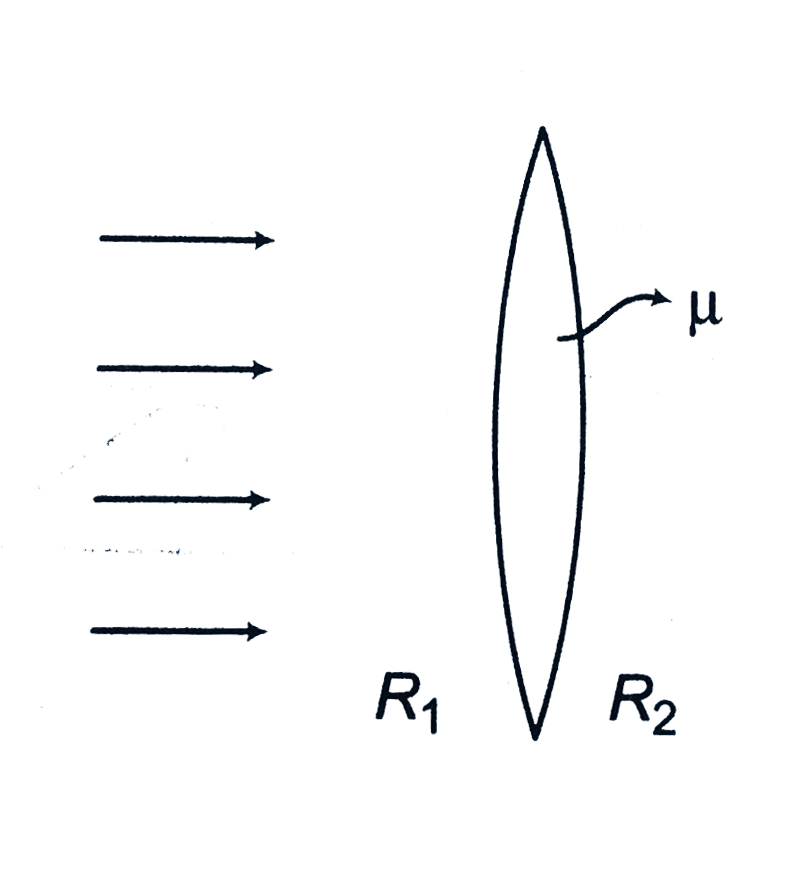A beam of light coming from infinty is passing through a biconvex lens having radius of curvature of each surface, if focused at a certain distance from lens. Find the radius of curvature of emergent wave front from lens : ()
To solve the problem, we need to determine the radius of curvature of the emergent wavefront from a biconvex lens when a beam of light coming from infinity passes through it. Here are the steps to arrive at the solution:
Step 1: Understand the Lens and Given Data
We have a biconvex lens with:
- Radius of curvature of each surface, R=20cm
- Refractive index of the lens, μ=1.5
Step 2: Identify the Lens Formula
The lens formula relating the focal length F of the lens to the radii of curvature R1 and R2 is given by:
1F=(μ−1)(1R1−1R2)
Where:
- R1 is the radius of curvature of the first surface (convex, positive)
- R2 is the radius of curvature of the second surface (concave, negative)
Step 3: Assign Values to R1 and R2
For our biconvex lens:
- R1=+20cm (first surface)
- R2=−20cm (second surface)
Step 4: Substitute Values into the Lens Formula
Now substituting the values into the lens formula:
1F=(1.5−1)(120−1−20)
1F=0.5(120+120)
1F=0.5(220)=0.5(110)=0.510=120
Step 5: Calculate the Focal Length F
Now, taking the reciprocal to find F:
F=20cm
Step 6: Determine the Radius of Curvature of the Emergent Wavefront
The radius of curvature of the emergent wavefront from the lens is equal to the focal length of the lens. Therefore, the radius of curvature of the emergent wavefront is:
Remergent=F=20cm
Final Answer
The radius of curvature of the emergent wavefront from the lens is 20cm.
---
We have a biconvex lens with:
- Radius of curvature of each surface, R=20cm
- Refractive index of the lens, μ=1.5
The lens formula relating the focal length F of the lens to the radii of curvature R1 and R2 is given by:
1F=(μ−1)(1R1−1R2)
Where:
- R1 is the radius of curvature of the first surface (convex, positive)
- R2 is the radius of curvature of the second surface (concave, negative)
For our biconvex lens:
- R1=+20cm (first surface)
- R2=−20cm (second surface)
Now substituting the values into the lens formula:
1F=(1.5−1)(120−1−20)
1F=0.5(120+120)
1F=0.5(220)=0.5(110)=0.510=120
Now, taking the reciprocal to find F:
F=20cm
The radius of curvature of the emergent wavefront from the lens is equal to the focal length of the lens. Therefore, the radius of curvature of the emergent wavefront is:
Remergent=F=20cm
The radius of curvature of the emergent wavefront from the lens is 20cm.
Similar Questions
Knowledge Check
The power of a biconvex lens is 10 dioptre and the radius of curvature of each surface is 10 cm. Then the refractive index of the material of the lens is
A32B43C98D53A biconvex lens has focal length 23 times the radius of curvature of either surface. Calculate refraction index f material of the lens.
A1.75B1.33C1.5D1.0A convex lens of radii of curvature 20cm and 30 cm respectively. It is silvered at the surface which has smaller radius of curvature. Then it will behave as (μg=1.5)
Aconcave mirror with equivalent focal length 3011cm.Bconcave mirror with equivalent focal length 6011cm.Cconvex mirror with equivalent focal length 3011cm.Dconvex mirror with equivalent focal length 6011cm.
For a plano convex lens, the radius of curvature of convex surface is 10 cm and the focal length is 30 cm. The refractive index of the material of the lens is
View SolutionA double convex lens has focal length 25 cm. The radius of curvature of one of the surfaces is double of the other. Find the radii, if the refractive index of the material of the lens is 1.5.
View SolutionIf in a planoconvex lens, the radius of curvature of the convex surface is 10cm and the focal length is 30cm, the refractive index of the material of the lens will be
View SolutionFind the refractive index of the material of a plano-convex lens, if the radius of curvature of the convex surface is 20 cm and focal length of the lens is 60 cm?
View SolutionThe radius curvature of each surface of a convex lens of refractive index 1.5 is 40 cm. Calculate its power.
View Solution

